When your garage door grinds to a halt and refuses to open, a broken spring is almost always the culprit. The good news is that it’s a common fix, but what should you expect to pay? Generally, a garage door spring replacement cost falls somewhere between $150 and $350 for a single spring, which covers both the new part and the professional labor to get it done right.
This price gives you a solid baseline for budgeting for this must-do repair.
Your Guide to Understanding Spring Replacement Costs
A broken garage door spring isn’t just an inconvenience—it’s a total shutdown of the system's most critical part. Think of the springs as the muscles doing all the heavy lifting for your door. Without them, your automatic opener is trying to lift hundreds of pounds by itself, a job it was never designed for. Pushing it too hard can lead to even more damage.
This guide is your roadmap to understanding exactly what goes into this repair, from the different types of springs to how labor costs are calculated.
What Your Investment Covers
It helps to know what you're paying for. The final bill isn't just for a new piece of metal; it’s a combination of several key services that ensure your door is safe and works perfectly.
Here’s what’s usually included:
- The Spring Itself: The physical part, with costs varying based on the type, size, and quality of the spring.
- Professional Labor: This covers the technician’s time and, more importantly, their expertise in safely removing a high-tension broken spring and installing the new one.
- System Balancing: After the new spring is in, the technician meticulously adjusts its tension to perfectly match your door's weight. This is a crucial step.
- Safety Inspection: A good pro will also check related parts like cables, rollers, and brackets to make sure the whole system is in good shape.
A properly balanced door is the secret to smooth, quiet operation and a longer life for your garage door opener. This final adjustment is one of the most important parts of a professional spring replacement.
Cost Breakdown Overview
Let's get into the numbers. To give you a clearer picture, here’s a quick summary of what you can expect to pay for a spring replacement.
Quick Cost Summary for Spring Replacement
| Service Type | Estimated Parts Cost | Estimated Labor Cost | Total Estimated Range |
|---|---|---|---|
| Single Spring Replacement | $50 – $100 | $100 – $250 | $150 – $350 |
| Double Spring Replacement | $100 – $200 | $150 – $300 | $250 – $500 |
Based on aggregated data from 2025, the cost to replace a single garage door spring typically lands between $150 and $350. This all-in price covers both materials and labor, with the labor portion alone making up roughly $75 to $150 of the total.
Of course, things like the spring type (torsion vs. extension) and regional labor rates will nudge the final price up or down. For example, replacing springs on a heavier double garage door often adds an extra $15 to $30 per spring. For more pricing insights, you can see what homeowners are paying on Angi.com.
Keeping up with routine maintenance can often stop these sudden, costly failures before they happen. You can learn more about how regular inspections reduce the need for garage door spring repair in our detailed article. Next, we'll break down these costs even further to help you budget wisely.
Breaking Down Your Repair Bill
When you get an invoice for a spring replacement, it can look a little confusing at first. But each line item tells a story, and understanding your bill is the key to seeing the value in the service you’re paying for. The total garage door spring replacement cost really boils down to two main things: materials and labor.
These two parts are the foundation of your repair bill. Let’s pull back the curtain on what each charge actually covers so you know exactly where your money is going.
The infographic below gives you a clear visual of how a typical repair bill is put together, showing how parts, labor, and other potential fees all fit in.
As you can see, the costs for the parts and the work are often pretty close, with the labor sometimes making up a big chunk of the final price.
The Cost of Materials
The "materials" or "parts" line on your invoice is about more than just the new spring. While the spring is definitely the star of the show, its price can vary a lot based on its type, how well it's made, and how long it's designed to last.
- Spring Type: Torsion springs, which are mounted above the door, usually cost more upfront than extension springs that run along the side tracks. That’s because they have a more heavy-duty design and are tougher to manufacture.
- Build Quality & Lifespan: Springs are rated by "cycles"—one cycle is one full opening and closing of the door. A standard spring might be rated for 10,000 cycles. But you can also get a high-cycle spring rated for 20,000 cycles or more, which could double its lifespan for a higher initial cost.
- Warranty: Better-quality springs often come with a longer warranty, which is the manufacturer’s way of showing they’re confident in how long the part will last.
So, how does this shake out in real numbers? For a standard torsion spring rated for 10,000 cycles on a 150-pound door, the part itself can run anywhere from $96.12 to $112.00. That figure doesn't even include other necessary bits like fasteners, lubricants, or disposal fees, which can tack on another $14 to $16 to the job. You can dig into more detailed pricing on sites like Homewyse.com.
The Value of Professional Labor
The labor charge on your bill covers so much more than just the time it takes to swap out a spring. When you pay for professional labor, you're really investing in a technician's specialized expertise to handle a dangerous, high-tension system safely and correctly. This is one repair where you absolutely don't want to cut corners.
A technician’s labor fee is an investment in safety, precision, and long-term performance. It ensures the job is done right, preventing future damage and protecting your property.
Here’s a breakdown of what that labor charge typically includes:
- Safety and Expertise: Technicians are trained to safely release the massive amount of tension stored in old springs and correctly wind the new ones. This knowledge is what prevents serious injuries and property damage.
- Specialized Tools: This job requires specific tools, like winding bars, that most people don't just have lying around in their garage.
- Travel and Diagnosis: The fee also covers the technician’s time to get to your home and their initial assessment of what’s wrong with the system.
- Balancing and Testing: This is the final, and most critical, step. A technician meticulously adjusts the spring tension to match your door's exact weight. This ensures it operates smoothly and doesn't put extra strain on the opener.
It’s an intricate process, but it helps to understand the steps involved. If you're curious about the technical side of things, our guide on how to change garage door springs gives a detailed look at how the pros handle it.
Torsion Springs vs. Extension Springs
Not all garage door springs are created equal. The type you have—or choose for a replacement—directly impacts the cost, safety, and performance of your entire system. The two main players in this game are torsion springs and extension springs, and knowing the difference is key to making a smart decision for your home.
Think of it like choosing an engine for a car. One is a modern, high-performance option built for longevity, while the other is a more traditional, standard choice. Both get the job done, but their design, durability, and cost are worlds apart.
The High-Performance Option: Torsion Springs
Torsion springs are the modern, more robust system you'll see on most newer garage doors. You’ll find them mounted on a metal shaft right above the door opening. Instead of stretching, they work by twisting (creating torque) to store and release energy. This provides a much more controlled and balanced lift every single time.
This superior design comes with some clear advantages:
- Smoother Operation: They lift the door evenly, which means no more jerky movements that can strain the panels and opener.
- Longer Lifespan: A standard torsion spring is rated for 10,000 to 15,000 cycles (one cycle is a full open and close), and high-cycle options can last even longer.
- Enhanced Safety: This is a big one. If a torsion spring breaks, it stays contained on the metal shaft instead of flying across your garage.
Because they’re better engineered, torsion springs have a higher upfront parts cost, usually running from $75 to $150 per spring. The extreme tension they're under also means this is not a DIY job. Learning how to change garage door torsion springs is a task best left to trained pros with the right tools and expertise to do it safely.
The Standard Choice: Extension Springs
Extension springs are the older, more traditional system. You’ll find them running parallel to the horizontal tracks on each side of your garage door. They work by stretching and contracting to lift the door’s weight—kind of like a massive, heavy-duty rubber band.
While they have a lower initial parts cost, they come with a few trade-offs.
Extension springs are a functional system but lack the durability and safety features of a modern torsion setup. The primary safety concern is the risk of the spring flying off its track if it snaps.
They are more prone to creating an uneven, jerky lift, which can wear on your door over time. Their biggest drawback is safety; if one snaps without a safety cable running through it, the broken piece can become a dangerous projectile. They also have a shorter lifespan, typically rated for just 5,000 to 10,000 cycles.
Torsion vs Extension Spring Comparison
So, how do these two spring types really stack up against each other? This table breaks down the key differences to help you see why one might be a better fit for your home than the other.
| Feature | Torsion Springs | Extension Springs |
|---|---|---|
| Location | Mounted on a shaft above the door | Run alongside the horizontal tracks |
| Lifespan | 10,000 – 15,000 cycles | 5,000 – 10,000 cycles |
| Operation | Smooth, balanced lift | Can be jerky and uneven |
| Safety | Safer; spring stays on the shaft if it breaks | High risk; can fly off if it breaks without a safety cable |
| Cost (Parts) | $75 – $150 per spring | $25 – $50 per spring |
| Best For | Heavier, wider, and modern doors | Lighter, older, or low-headroom doors |
Ultimately, while extension springs might save you a little money upfront, torsion springs offer far better value in terms of safety, durability, and performance. A qualified technician can help you decide which system makes the most sense for your specific door and budget.
How Your Location Impacts Repair Prices
One of the biggest factors that can swing your final garage door spring replacement cost is, believe it or not, your address. A repair job in a bustling city is almost always going to be priced differently than the same work in a quiet rural town. This isn't random—it's tied directly to the local economy.
The main reason for this price gap is the regional labor rate. Just like a gallon of gas or a loaf of bread costs more in a major metro area, so does skilled labor. Companies in high-cost-of-living cities have to pay their technicians more, and they also face higher operating expenses like insurance, rent, and fuel. All of that gets baked into the final service fee.
Labor Rates And Business Expenses
Think of it like buying a cup of coffee. The exact same latte from the same national chain will cost you more in downtown Los Angeles than it will in a small town out in the Midwest. The coffee beans are identical, but the business costs—rent, wages, local taxes—are worlds apart. Garage door repair services work on the very same principle.
Your geographic location sets the baseline for labor costs. The local economy directly influences what technicians are paid and what businesses must charge to operate sustainably, creating natural price variations from one region to another.
These differences can be pretty significant. For example, you’ll see some stark contrasts in spring replacement costs across the country. In major U.S. cities like Los Angeles, the total cost for a single spring can be much higher than in other areas. Meanwhile, places like New York and New Jersey often see prices around $275 for one spring and $550 for two. You can find more details on these regional cost differences at UpstateDoors.com.
Travel Fees And Surcharges
On top of the base labor rate, your specific spot on the map within a company's service area can also nudge the price up. If you live in a remote or rural area that’s a long haul from the company's home base, you might see an extra charge on your invoice.
This isn't a penalty; it’s a practical way for the business to cover the technician’s extra travel time and fuel costs. These surcharges allow companies to serve a wider community while making sure their team is fairly compensated for all that time spent on the road.
This is exactly why getting quotes from local companies is so important. A professional in your immediate area will give you a number that reflects these geographic factors, setting a realistic expectation for what the final repair will cost.
Why Professional Installation Is a Smart Investment
Let's be blunt: attempting to replace a garage door spring yourself is one of the riskiest home repair projects you can possibly take on. While it might look like a way to shave a few bucks off the garage door spring replacement cost, that professional labor charge is a critical investment in your safety and the health of your entire garage door system.
You aren’t just paying for a simple fix. You're paying for expertise, precision, and—most importantly—peace of mind.
The Hidden Danger Stored in the Springs
A garage door spring under tension is a powerhouse of stored kinetic energy. To put that into perspective, imagine trying to hold back a fully drawn catapult with your bare hands. A wound torsion spring contains a similar, explosive force, perfectly calibrated to lift hundreds of pounds of door weight.
When that tension is released the wrong way, the results can be catastrophic. The spring can snap and launch steel fragments across your garage with incredible speed, or the entire door can come crashing down. This isn't just a risk of property damage; it's a direct threat to anyone standing nearby.
A professional technician is trained to safely manage this immense energy. Their expertise turns a high-risk procedure into a controlled, routine repair, protecting your family and your property from preventable accidents.
This is exactly why handling these parts requires specialized training and tools. If you're curious about the specifics, our detailed guide explains why garage door repair should be left to the experts.
More Than Just a Simple Swap
Beyond the crucial safety factor, hiring a professional ensures the job gets done right. An expert technician brings a lot more to the table than just the ability to swap out an old spring for a new one.
Here’s what that professional touch really gets you:
- Correct Spring Matching: They will precisely measure your door's weight and dimensions to install the exact spring required. An incorrectly sized spring will either wear out in a fraction of the time or put a massive strain on your opener motor, leading to another expensive repair down the line.
- Perfect System Balancing: This is the most important step after the installation. A technician will carefully adjust the spring tension until the door is perfectly balanced, meaning it can hold its position halfway open without any help. This perfect equilibrium is the secret to smooth, quiet operation for years to come.
- Comprehensive Safety Checks: A pro will inspect the whole system—cables, rollers, brackets, and tracks—to spot any other worn-out parts that could cause trouble later. This preventative approach saves you from future surprise breakdowns.
- Warranty and Accountability: Professional service comes with a warranty on both the parts and the labor. If something goes wrong with the new spring or the installation, the company is accountable for making it right. That’s a valuable safety net you just don't get with a DIY job.
When you really break it down, the labor fee is a small price to pay for the value it delivers. It's an investment that ensures your garage door operates safely, reliably, and efficiently, preventing far more expensive—and dangerous—problems from ever happening.
Common Questions About Spring Replacement Costs
Even with a detailed cost breakdown, you probably still have a few questions. When it comes to something as important as your garage door springs, getting clear, direct answers helps you feel confident about the repair.
Think of this as your go-to FAQ for clearing up those last-minute uncertainties. We’ll cover everything from timing the repair to how long your new parts will last.
Should I Replace Both Springs if Only One Is Broken?
The short answer? Yes, absolutely. It might seem like you’re saving money by only replacing the one that snapped, but it’s a decision you’ll likely regret in a few months.
Garage door springs are installed in pairs and do the exact same amount of work. They lift and lower the door together, meaning they wear out at the same rate. When one gives out, the other is living on borrowed time.
Here’s why replacing both is always the smart move:
- Balanced Tension: A brand-new spring paired with a tired, old one creates a serious imbalance. This forces your door to lift unevenly, which puts a ton of strain on the opener motor and can even warp the door panels.
- Consistent Lifespan: With two new springs, you reset the clock. Both will be rated for the same number of cycles, so you won’t be calling a technician for the exact same problem a few months down the road.
- Long-Term Savings: While it costs more upfront, you save big by avoiding a second service call and another labor fee. An International Door Association survey even found that replacing both springs can extend the entire mechanism's lifespan by up to 40%.
What Is the Lifespan of a Garage Door Spring?
The durability of a garage door spring isn’t measured in years, but in "cycles." One cycle is one full opening and closing of the door. How long that takes in real-world time depends entirely on how you use your garage.
Here’s a general idea of what to expect:
- Extension Springs: These are the more basic option and typically last for 5,000 to 10,000 cycles. For the average family, that translates to about 5 to 10 years.
- Torsion Springs: These are the heavy-lifters. They’re more durable and are rated for 10,000 to 15,000 cycles, which usually gets you somewhere between 7 and 15 years of use. You can even get high-cycle torsion springs that last longer.
Remember, your daily habits are the biggest factor here. If your family opens and closes the door ten times a day, you’ll burn through those cycles much faster than someone who only uses it twice a day.
How Do I Know if My Springs Are Failing?
Springs almost never break without giving you a few warning signs first. If you can spot the early red flags, you can schedule a repair before you find your car trapped in the garage.
One of the clearest indicators of a failing spring is a door that feels incredibly heavy when you try to lift it manually. If the spring system is working correctly, you should be able to lift a several-hundred-pound door with just one hand.
Other common signs that trouble is brewing include:
- A sudden, loud bang or snap coming from the garage.
- The door moves unevenly or looks crooked as it opens.
- You can see visible gaps in the spring coils when the door is closed.
- The door slams shut instead of closing smoothly.
Catching these issues early does more than just prevent a headache—it saves other parts of your system, like the opener and tracks, from unnecessary damage. That keeps the final repair bill focused just on the springs.
When it's time for a professional, safe, and reliable spring replacement, the team at Security Door Gate and Fence is ready to help. Our experienced technicians ensure your garage door is perfectly balanced and secure. Schedule your service today.


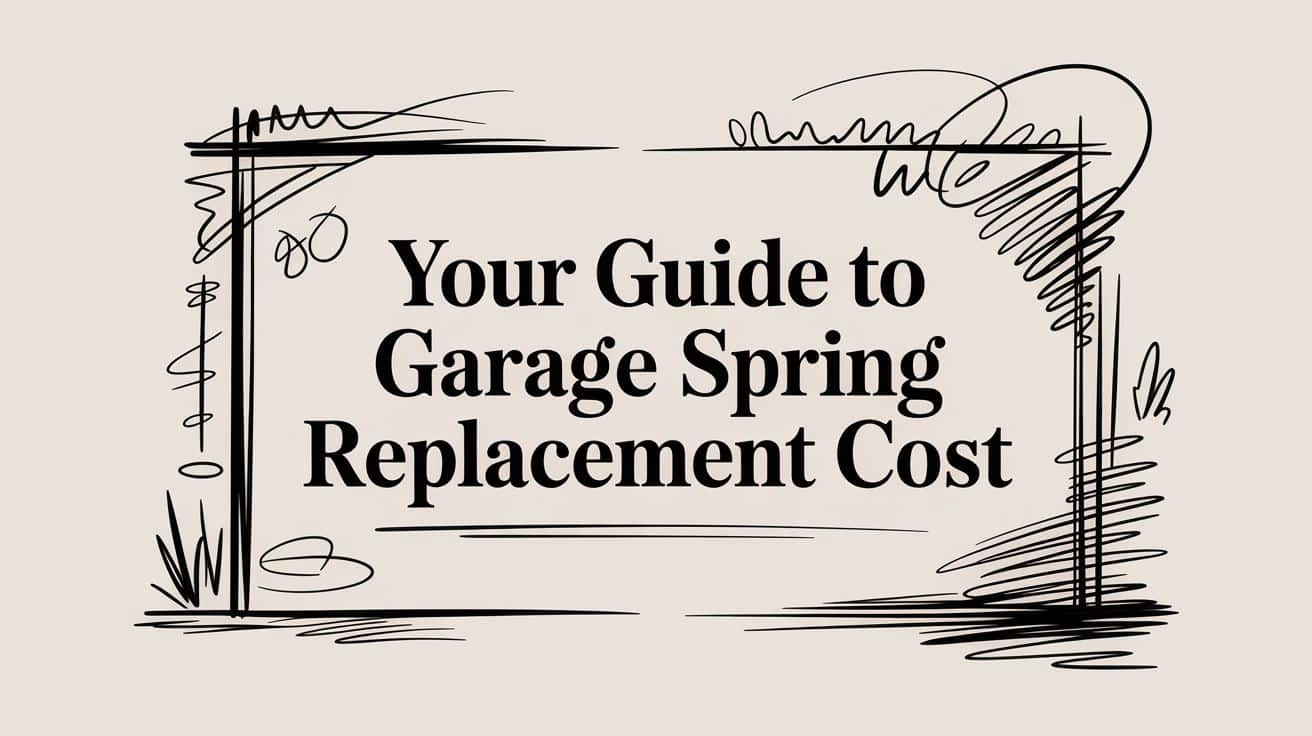

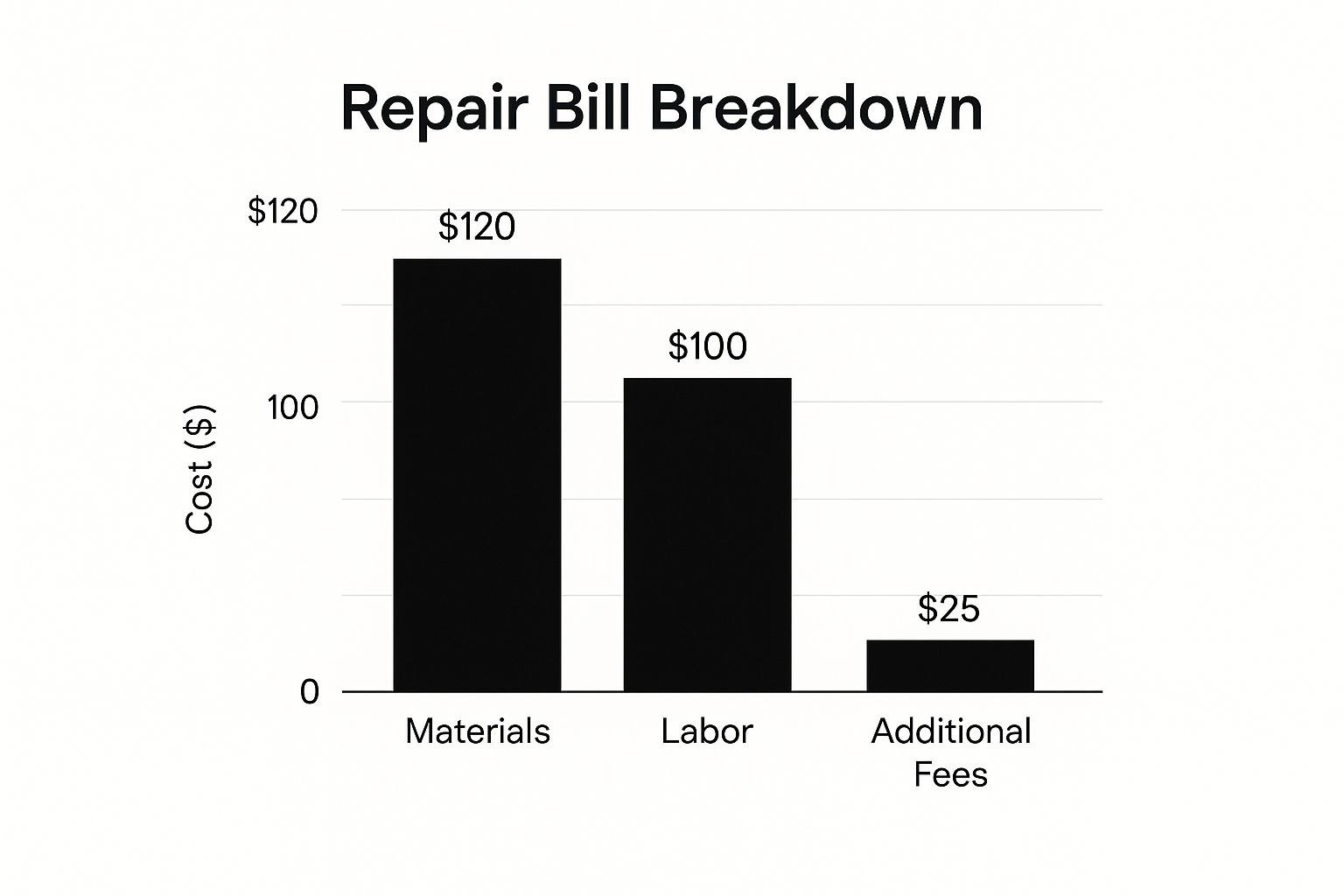
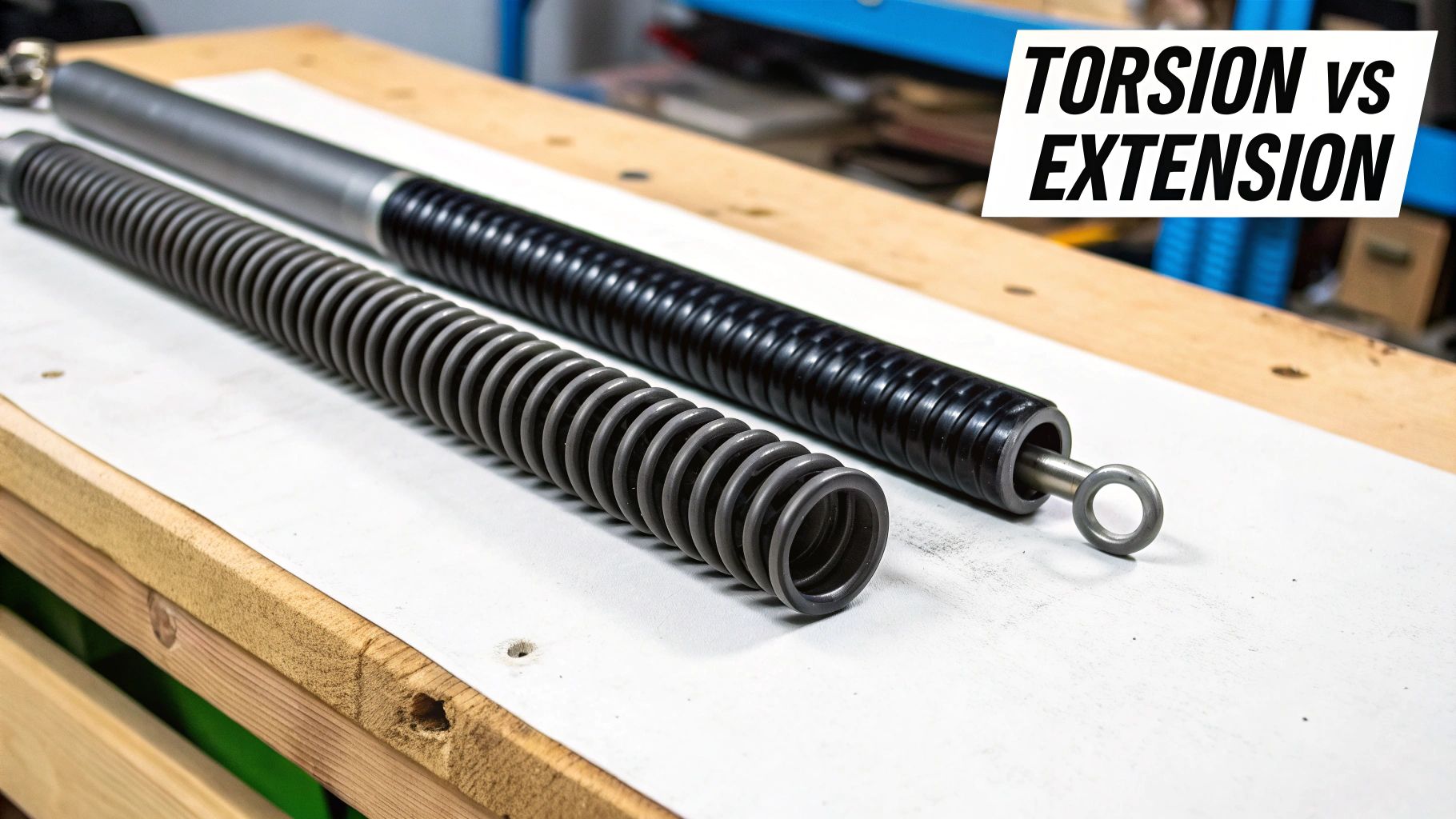
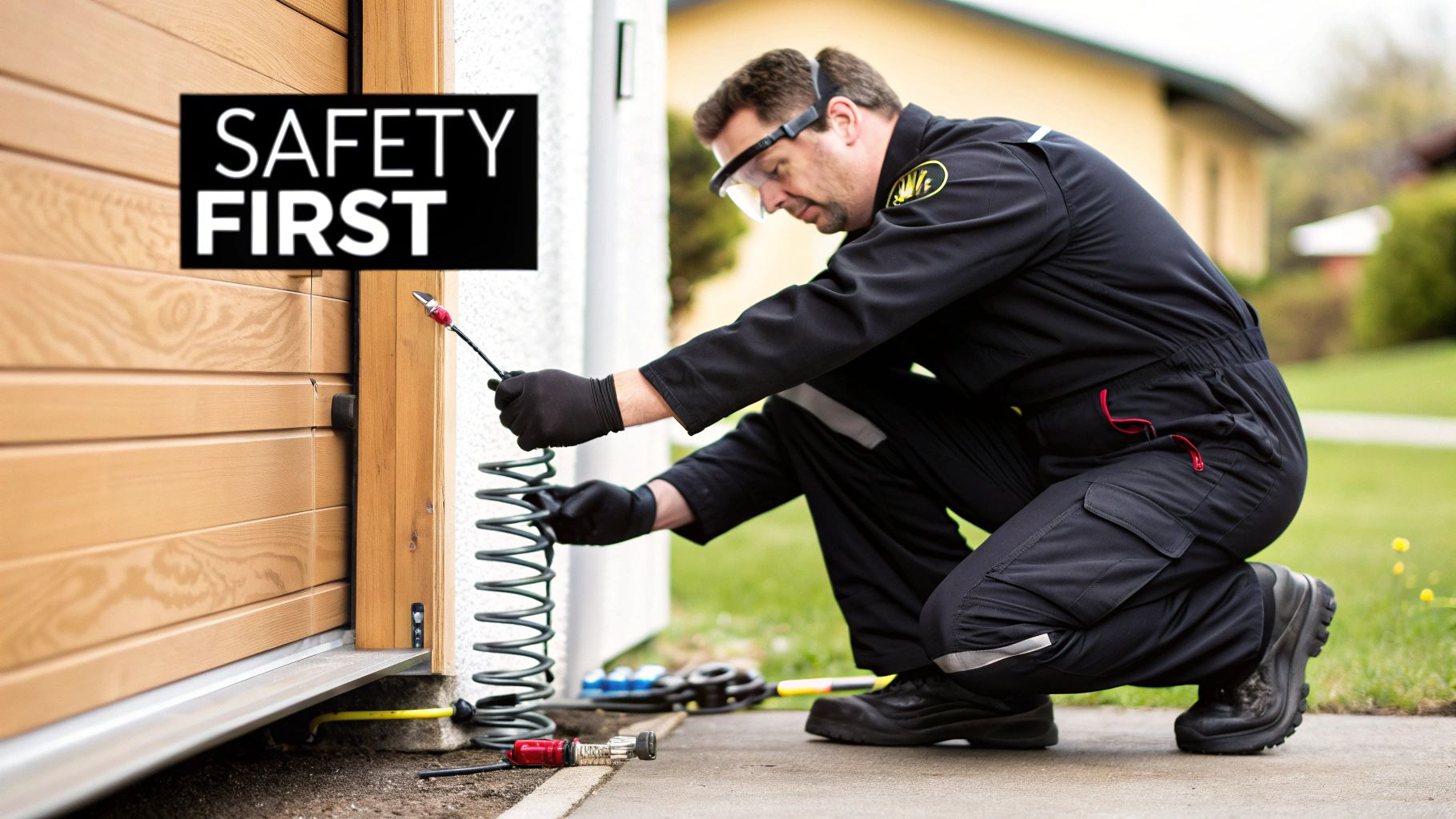

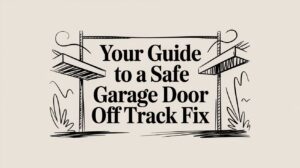


 (480) 548-0807
(480) 548-0807